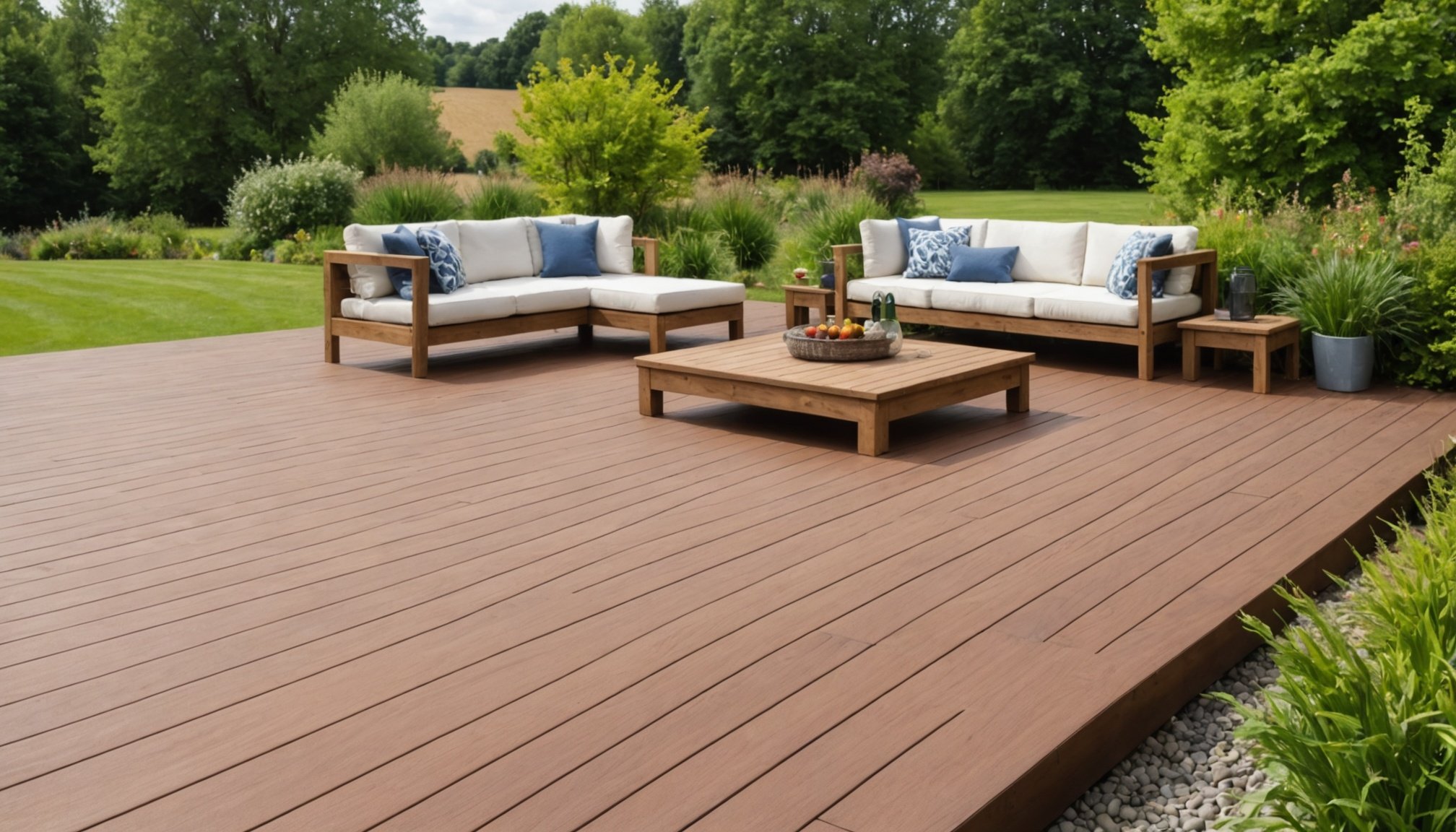Your Ultimate Guide to Choosing Sustainable Timber for Outdoor Decking in Rural UK Homes
When it comes to enhancing your rural UK home with an outdoor decking, the choice of timber is crucial for both aesthetic and practical reasons. Here’s a comprehensive guide to help you select the most sustainable and suitable timber for your outdoor decking project.
Why Choose Sustainable Timber?
Sustainable timber is not just an eco-friendly choice, but it also offers long-term benefits in terms of durability and maintenance. Here are a few reasons why sustainable timber should be your top pick:
This might interest you : Unlocking hot water savings: optimize your uk semi-detached home with solar thermal solutions
- Environmental Impact: Sustainable timber is sourced from responsibly managed forests, ensuring that the harvesting process does not harm the environment. This aligns with the growing awareness and need for eco-friendly practices in home improvement projects[2][3].
- Durability: Sustainable timber, when properly treated, can last for decades. For instance, British Cedar cladding is known for its natural resistance to rot, decay, and insect damage, making it an ideal choice for outdoor applications[1].
- Aesthetic Appeal: Sustainable timber offers a natural beauty that can enhance the look of your garden and home. Whether you opt for the rich tones of British Cedar or the rustic charm of reclaimed timber, the aesthetic appeal is undeniable[1][2].
Types of Sustainable Timber for Decking
There are several types of sustainable timber that you can consider for your decking project. Here are some of the most popular options:
British Cedar
British Cedar is a premium choice for outdoor decking due to its lightweight, durable, and naturally resistant properties. It is available in various profiles such as Tongue and Groove, Shadow Gap, and Shiplap, making it versatile for both modern and traditional designs[1].
Also read : Eco-friendly garage transformation: innovative sustainable design tips for uk homeowners
Pressure-Treated Timber
Pressure-treated timber is another excellent option, especially for areas prone to harsh weather conditions. This type of timber is treated to resist rot, decay, and moisture absorption, ensuring it remains stable and secure throughout the year. Brookridge Timber offers a range of pressure-treated timber products that are ideal for decking, fencing, and other garden structures[2].
Reclaimed Timber
Reclaimed timber adds a rustic charm to your garden and is a great way to reuse old wood. It is durable and can be used for various applications, including raised beds, retaining walls, and decking. Reclaimed sleepers from Brookridge Timber are particularly useful for creating unique and sustainable garden features[2].
Composite Decking: A Sustainable Alternative
For those looking for a non-wood option, composite decking is a highly sustainable alternative. Here’s why:
Millboard Composite Decking
Millboard composite decking is made from a unique polymer resin construction that mimics the look of natural wood but offers superior durability. It is created using recycled materials and contains no natural timber, making it an eco-friendly choice. The Lastane surface provides exceptional weather resistance and slip resistance, even when wet[3].
Key Considerations for Your Decking Project
Before you start your decking project, here are some key considerations to keep in mind:
Weather Resistance
The UK weather can be unpredictable, with snow, heavy rain, and high winds common during winter. Ensure your decking material is weather-resistant. Pressure-treated timber and composite decking are excellent choices for withstanding harsh weather conditions[2][3].
Maintenance
While sustainable timber requires less maintenance than untreated wood, it still needs some care. Regularly sweep away snow and debris, use weatherproof sealants, and ensure adequate drainage to prevent water pooling underneath the deck[2].
Slip Resistance
Slip resistance is crucial, especially in areas that can get wet. Composite decking like Millboard offers superior slip resistance due to its unique Lastane surface. For timber decking, consider adding anti-slip inserts to enhance safety[2][3].
Design and Aesthetic
Your decking should complement the design of your home and garden. Choose a timber that fits your architectural style, whether it’s modern or traditional. British Cedar, for example, can be left untreated to weather into a silvery-grey patina or finished with stains and oils for a personalized look[1].
Practical Tips for Building Your Deck
Here are some practical tips to help you build your deck efficiently and effectively:
Plan Your Project
- Measure Your Space: Ensure you have accurate measurements of your garden space to determine the amount of timber you need.
- Choose the Right Tools: Invest in good quality tools to make the construction process smoother.
- Consider DIY or Professional Help: Depending on your skills and time, decide whether to self-build or hire a professional.
Prepare the Site
- Clear the Area: Remove any debris or existing structures from the site.
- Level the Ground: Ensure the ground is level to prevent any unevenness in your deck.
- Lay the Foundation: Use durable materials for the foundation to support the weight of the deck.
Build and Maintain
- Follow Safety Guidelines: Always wear protective gear and follow safety guidelines when building your deck.
- Regular Maintenance: Regularly inspect and maintain your deck to extend its lifespan.
Top Treatments for Sustainable Timber
To ensure your sustainable timber lasts for years, here are some top treatments you can consider:
Thermo Modification
Thermo modification involves heating timber under high temperatures and pressure without oxygen. This process enhances the durability of the timber, making it resistant to rot, decay, and insect infestation. It is a chemical-free and long-lasting treatment[5].
Borate Treatments
Borates are natural salts that can be used to protect timber from insects and pests. They sink deeply into the timber, providing long-term protection without altering the structural integrity or appearance of the wood[5].
Natural Oils
Natural oils like linseed, tung, and teak oils have been used for centuries to protect wood. These oils replace the natural oils lost over time, creating a moisture-resistant barrier that reduces the chance of rot, warping, and swelling[5].
Limewash Treatments
Limewash is a breathable coating that keeps pests at bay while allowing moisture to escape. It provides a natural fire retardant layer and has a rustic, matte finish. However, it needs to be reapplied every 5-7 years[5].
Comparison of Sustainable Timber and Composite Decking
Here is a comparison table to help you decide between sustainable timber and composite decking:
| Feature | Sustainable Timber | Composite Decking |
|---|---|---|
| Material | Natural wood from responsibly managed forests | Polymer resin with recycled materials |
| Durability | Long-lasting with proper treatment | Highly durable and resistant to weather |
| Maintenance | Requires regular maintenance | Low maintenance, resistant to rot and decay |
| Aesthetic | Natural beauty, can be finished or left untreated | Realistic wood grain texture, various colors |
| Slip Resistance | Can be enhanced with anti-slip inserts | Superior slip resistance due to Lastane surface |
| Cost | Varies depending on type and treatment | Generally more expensive than untreated timber |
| Eco-Friendliness | Sustainable sourcing, can be reused or recycled | Made from recycled materials, no natural timber |
Real-Life Examples and Testimonials
Here are some real-life examples and testimonials to inspire your project:
One Acre Wood Treehouses
One Acre Wood in Herefordshire features luxurious treehouses built using high-quality, sustainably sourced wood. The treehouses are designed to blend seamlessly into the natural landscape, offering a unique and immersive experience. The use of local materials and sustainable design ensures minimal environmental impact[4].
Suzie Jewell’s Experience with Millboard
Suzie Jewell, a Landscape Architect at Kew Gardens, has specified Millboard products for several design projects. She praises Millboard for its durability and anti-slip properties, making it an ideal choice for outdoor spaces that need to withstand various weather conditions[3].
Choosing sustainable timber for your outdoor decking is a decision that not only benefits the environment but also enhances the beauty and functionality of your garden space. Whether you opt for British Cedar, pressure-treated timber, or composite decking, ensuring that your materials are sustainably sourced and properly treated is key to a successful and long-lasting project.
By following the practical tips and considerations outlined in this guide, you can create an outdoor space that is both eco-friendly and visually appealing. Remember, the right choice of timber can make all the difference in upgrading your home and enjoying your outdoor space for years to come.
Additional Resources
For further guidance and inspiration, here are some additional resources you might find useful:
- Brookridge Timber: Offers a range of high-quality timber products and expert advice for protecting your garden from harsh weather conditions[2].
- EcoChoice: Provides detailed information on various timber treatments and sustainable practices for maintaining your timber beams[5].
- Millboard: Specializes in premium wood-free composite decking and cladding, offering a sustainable alternative to traditional timber[3].
By leveraging these resources and the insights from this guide, you can ensure that your decking project is not only successful but also sustainable and beautiful.

